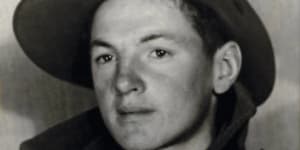The war didn’t kill him,but COVID-19 complications claimed his life at the age of 96.
Historian Lynette Silver,who has written extensively on Sandakan,said:“Always a larrikin,Billy was irrepressible,even in captivity. His will to survive carried him through torture and interrogation,enabling him to endure months of solitary confinement in Outram Road,his punishment for an escape attempt.
“Devastated by the knowledge at war’s end that only six POWs out of 2434 had survived at Sandakan,Billy later worked through his grief and trauma by writing poetry and creating a series of paintings depicting life,and death,in the camp and prison,the only visual records we have.”
“He was always aware of how lucky he was to survive and from the day of his liberation lived life to the fullest. Indomitable to the end,he was a remarkable man and a wonderful Australian.”

Former POW Billy Young in 2012.Supplied
Keith William Young was born on November 4,1925,in New Town,Hobart. He worked as a telegram delivery boy on a bicycle,before deciding to ride around Australia with a mate.
Police picked him up in Victoria,near the South Australian border. Sent to a Melbourne boys’ home,he absconded,put his age up four years and enlisted.
At the time,the 15-year-old was an orphaned delinquent at something of a loose end and knew the army would feed him.
Young was posted to the 3rd Reinforcements of the 29th Infantry Battalion and sent with the 8th Division to Malaya. A month after his 16th birthday,the Japanese stormed through Malaya to Singapore. Young joined the walking wounded on February 12,1942.

Billy Young at 15,before departing Australia for Malaya in September 1941.SUPPLIED
He was among hundreds of other soldiers shipped to Borneo to build a Japanese airstrip at Sandakan in the Malaysian jungle. It was hot,humid and overrun by mosquitos.
Billy spent his 17th birthday in the infamous Sandakan prisoner-of-war camp and much of the rest of the war in the notorious Outram Road jail.
Only six Australians,of 1787 fellow countrymen and 641 Britons,survived the Sandakan camp,the 265km “death march” through mountainous jungle to Ranau,and the wretched destination itself.
After the war Young wrote his story on an electric typewriter and expressed his experiences in poetry. He learned to draw scenes he remembered from his days of imprisonment. He then took to canvas and acrylic paints.
Billy Young was made a Member of the Order of Australia in 2004 for helping to bring the Sandakan story to Australians.
The Morning Edition newsletter is our guide to the day’s most important and interestingstories,analysis and insights.